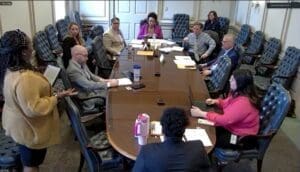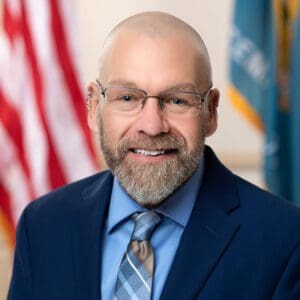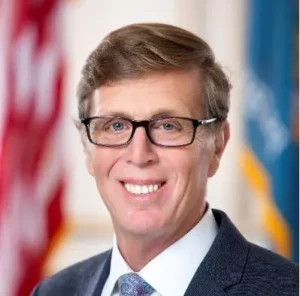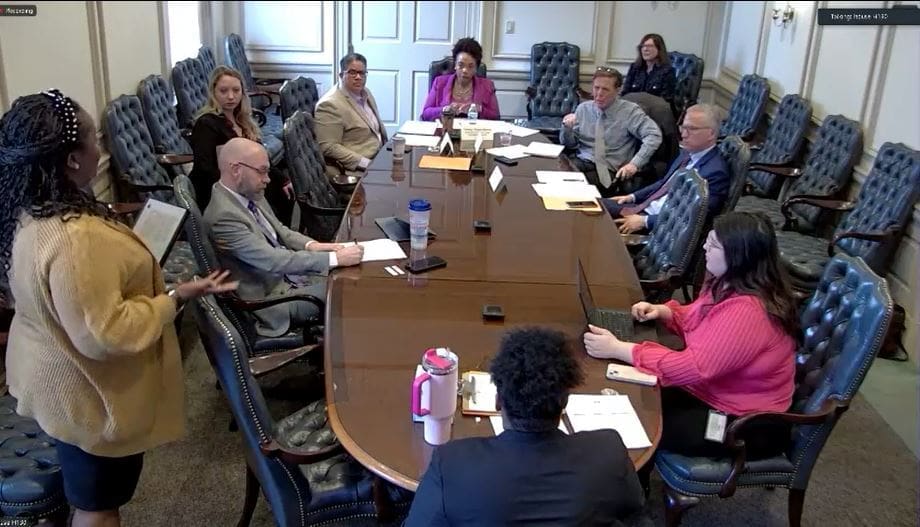
Nandi Randolph, left, of the Delaware Family Policy Council speaks against a bill proposed by Rep. Eric Morrison, seated left, that would add asexuality and pansexuality to the state’s legal definition of sexuality.
A move to add asexuality and pansexuality to the state definition of sexual orientation led to conversations about what those terms mean — and a warning that adding them could one day lead to adding pedophiles, too.
Rep. Eric Morrison, D-Newark/Bear, said the idea for House Bill 275 came from a member of Delaware’s LBGTQ+ community who identifies as pansexual.

Eric Morrison
State law now defines sexual orientation as heterosexuality, homosexuality or bisexuality.
That definition provides legal protections for those groups that would not exist for someone who identifies as asexual or pansexual, Morrison said.
Asexuality refers to individuals with little to no sexual attraction to other individuals, although asexual individuals may desire emotionally intimate relationships with other individuals.
Pansexuality refers to individuals who are attracted sexually or romantically, or both, to another individual regardless of that individual’s sex or gender identity.
“That’s a lot of words,” Morrison said in Wednesday’s House Administration Committee. “But one example is that you may have someone who’s heterosexual or heterosexual male, who of course is interested in women. However, they would not be or want to be with a trans woman.
“A pansexual individual is open to anyone. They would be willing to date someone or see someone who is trans.”
Morrison, who said he’s been active in LGBTQ+ groups for 31 years, believes the numbers of people who identify as asexual or pansexual are increasing as they feel more comfortable and safe about being honest about who they are.
By adding them to the sexual orientation definition, the state reinforces that discrimination or hate crimes based on those orientations receive the same protections under the law as heterosexuals, homosexuals and bisexuals.
Sending message about sexuality
It also sends a message to asexual and pansexual state residents that the are valued every bit as much as heterosexual, gay and bisexual people.
“Representation matters and words matter, and it also matters seeing yourself represented,” Morrison said.
He also hopes the legislation will help educate his fellow Delawareans about asexuality and pansexuality “and let them know that whether or not they know it, they have fellow Delawareans in their everyday lives who are asexual and pansexual.”

Mike Ramone
House Minority Leader Mike Ramone, R-Pike Creek/Newark, noted that homosexuals have faced abuse that heterosexuals have not. But, he said, he was not sure why asexual people and pansexual people needed to be broken out of the current umbrella definition.
Morrison responded that all LGBTQ+ people still face a lot of discrimination and abuse.
Ramone asked whether changing the state definition made it worse by breaking it out even more.
“You’re this, but you’re in that part of this, so you’re going to be treated differently,” he said. “Are we making it worse?”
Morrison said state law now “kind of pretends” that the three sexual orientations listed are the only ones.
“Someone who is asexual cannot identify as heterosexual, homosexual or bisexual,” Morrison said. “And somebody who is pansexual would not identify as any of those.”
He said asexual people may not be interested in sex with either a man or a woman at all, but seek relationships that are purely emotional. They wouldn’t fall into any of those other categories, he said.
Morrison said he believes it’s hardest for people to wrap their minds around the concept of pansexual.
The best example, he said, is that pansexual people are open to exploring or having romantic and emotional relationships with anybody on the spectrum.
Ramone made a few more comments and then tried to assure Morrison he wasn’t trying to find a reason to vote for.
“I’m one of t hose who say if this what people want, I’ll for it,” he said.
Asexual and pansexual can cause confusion within the LGBTQ+ community, Morrison said.
“I know a number of folks who identify as asexual and a number who identify as pansexual,” Morrison said. “They absolutely do not identify as heterosexual, homosexual or bisexual because it does not encode this spectrum.”
IN THE NEWS: Bipartisan bill would see inspector general at work in early 2025
During public comment, Nandi Randolph, policy analyst of the Delaware Family Policy Council, said her agency opposed the additions.
“Our code continues to follow the trends of popular culture,” she said. “The list of orientations continues to grow including what is now called minor-attracted persons.”
In the previous week, she said, “A senator expressed concern for how criminal legislation to help protect children would affect pedophiles negatively. It was discriminatory to MAPs. This is a slippery slope, but we can’t afford to continue down.”
Ramone looked puzzled and asked, “What is MAPs again?”
Randolph explained it meant minor-attracted persons.
“That’s a pedophile, essentially,” she said.
Morrison responded in controlled anger, saying he was disgusted by anyone who accused the LGBTQ+ community of being pedophiles.
Not once in his decades working the community had say they wanted to make pedophilia a sexual orientation, he said.
“That is ludicrous,” he said. “It is inflammatory. It is insulting.”
The bill passed out of the committee with four people, including Ramone, voting for it on its merits and one — Rep. Lyndon Yearick, R-Camden — voting no.
“On its merits” means the legislator didn’t wholly embrace the legislation, but believes it deserved a full vote in front of the House.

Betsy Price is a Wilmington freelance writer who has 40 years of experience, including 15 at The News Journal in Delaware.
Share this Post




